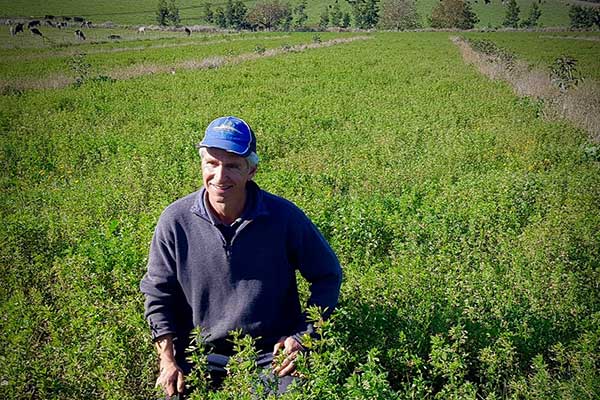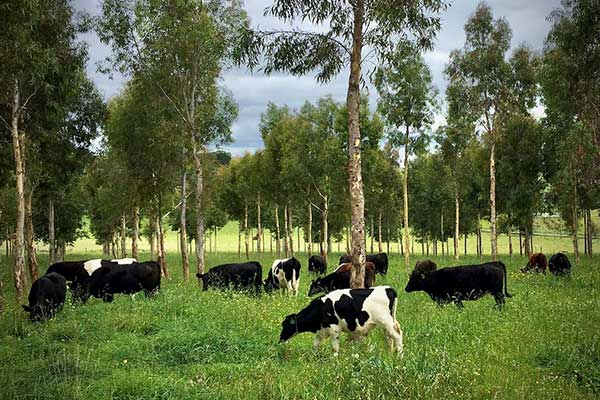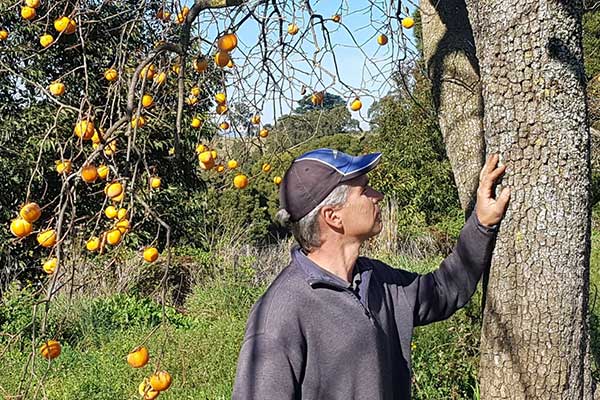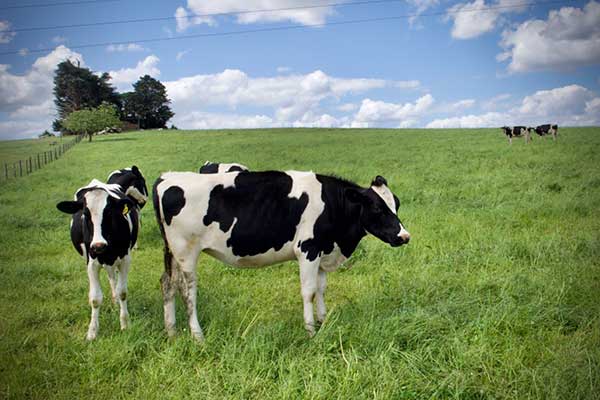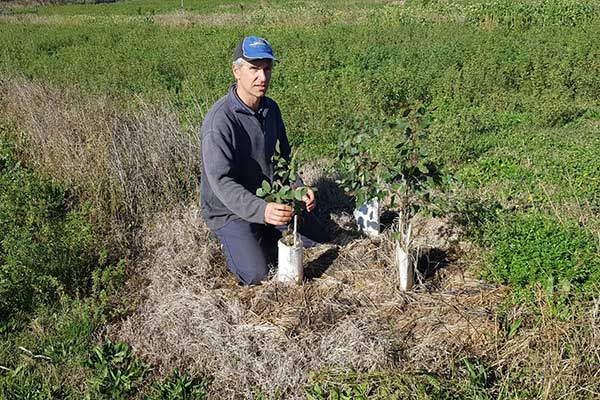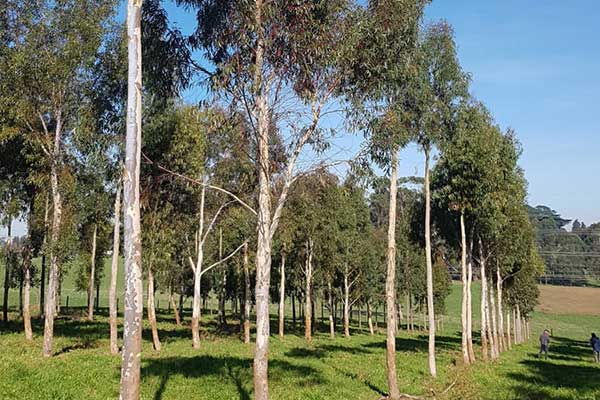Camaray Farm: Multi-Storey Farming
Farmers: Clinton & Michelle Tepper
Enterprise: Beef cattle, lucerne production and timber production
Catchment Management Region: Port Phillip and Westernport
Landcare Network: Westernport Landcare Network
LGA: Baw Baw Shire Council
Landform: Central Gippsland Plains
Soil Type: red ferrosol
Annual Rainfall average: 1003.4 mm (BoM Buln Buln observation station).
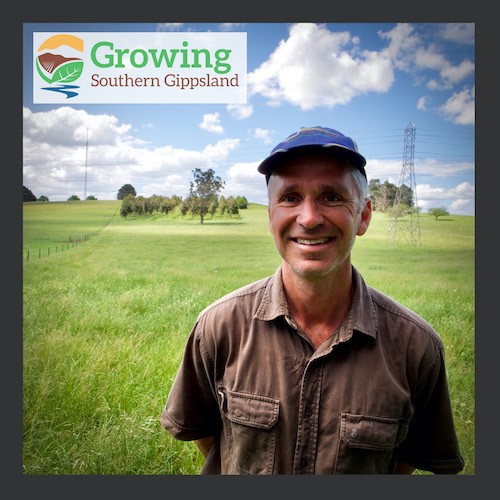
Clinton and Michelle Tepper are fourth generation farmers. Their main farm enterprises are fattening beef cattle and lucerne production supported by agistment of dairy cattle and firewood and timber production from planted trees. In 2014, Clinton sought to improve farm productivity and the length of the growing season by establishing a 1.2-hectare multi-storey farming demonstration site with assistance from the Westernport Catchment and Landcare Network (WCLPN). The term ‘multi-storey farming’ reflects Clinton’s background in forestry as the top, middle and bottom layers of the forest are referred to as storeys. This type of farming draws on Clinton’s experiences as a forester as well as learning from African farmers, via Beyond Subsistence , where getting the most out of the available resources is vital.
The demonstration site was established with assistance from the WPCLN “Demonstrating Sustainable Farm Practices’ Project and experts from Basix Trace Element Packs . In the process, the Teppers have defined a distinctive sustainable process and practice for farmers in Gippsland and beyond.
Thirteen rows of silvertop ash, spotted gum and silver wattle were planted on the demonstration site, at a distance of 5.25m to allow room for pasture to grow and the cattle to graze. There have been changes to the layout of the site, as well as experiments with different plantings. One change is that the initial distance between rows was found to be too narrow and the trees are now planted 10.5m apart. This example provides insights into how to experiment and innovate in methodical ways, as well as the benefits of the multi-storey farming system they have developed (The many benefits of multi-storey farming ).
Taking it to the top, while looking down
Multi-storey farming at Camaray integrates different “storeys”, the top, middle and lower layers of a forest and includes soil, pastures/crops, livestock and trees on one land unit (Practical Guide ). The system allows for a natural symbiosis, as the crops, trees and livestock work together to improve the resilience, sustainability, productivity and profitability of the trial site. As Clinton says:
“I’ve been involved with planting millions of trees, a lot of different species across hundreds of different farms in Victoria. I drew on that experience for the idea of the demonstration site.” (Multi-Storey Farming Demonstration )
Clinton also drew inspiration from visits to Africa:
“… these trips were a great revelation. In Uganda and Zimbabwe, the widespread integration of trees into cropping, pasture and horticulture systems by leading farmers, inspired me to think more broadly about the role of trees on a farm” (Just Add Trees ).
Within a month, the area between the rows in the demonstration site were planted out with pasture and cereal crops. Cattle were able to graze the crops between the trees 14 months after the demonstration site was established.
Experimentation has continued on the demonstration site; it has not just been planted and left to see what happens. More than 70 varieties of pasture and crops have been tested, and the best performers resown.
“… we learnt a lot about how trees integrate with pastures and crops in this particular system. What has worked and what hasn't. Over the years, we've had this farm, we've found real issues with moisture retention and growth, over January to May. And, we wanted to come up with a system that made our farm more productive and resilient in the face of challenging conditions. So, we came up with this system called multi-story farming, which is really just about integrating trees and crops together. Prior to establishment we seek to improve soil health and mineral balance to give the best chance of success. And, then we select pastures and crops, that are well matched to the site”.
The results have provided proof of concept for the Teppers. There has been greater water retention over the dry months in the trial paddock, due to shading reducing evaporation, which has extended the growing season for the pasture and crops.
“… something is always growing in this system. We're using more soil. Generally, pastures on a beef farm like this might use the top 20 to 30cm centimetres of soil. In this system, we've got trees as well as deeper-rooted perennial crops like lucerne. So, we've got roots down way beyond that 30 centimetres, up to meters. The different layers of vegetation intercept more sunlight another resource that we've already got, in turn fuelling higher levels of photosynthesis”
One critical benefit is that the livestock are also in better condition. The Teppers monitor the growth of the trees, which will be harvested to provide further income from the site, and the growth rates are comparable to the best hardwood sawlog plantations in the region.
The soil has been regularly tested and compared to an adjacent pastured control. The multi-storey farming approach has resulted in positive results for nitrogen, as well as decreased sodium.
“In the summer, we have an amazing advantage where every blade of grass pretty much in this demonstration site is covered by shade at some time during the day, which helps reduce moisture loss. And that's a wonderful advantage to have through a summer on these, red ferrosol soils that don't retain the moisture like some other soils might.”
The key lessons from the first four years of multi-storey farming may be summarized as:
- Productivity. By using more soil and more sun productively the length of the growing season can be improved significantly.
- Plant the trees further apart. The Teppers removed two of the middle rows in 2017, leaving 10.5m between rows rather than the original 5.25m:
“One of the key learnings that we've we found here is that that original spacing of 5.25 meters between rows was heavily biased towards timber production at the expense of pasture production”.
- Before establishment seek to understand the site and suppress weeds. The Teppers found it more difficult to suppress the Californian Thistle after planting: it would have been easier to control it before planting.
- Prepare the soil. Given the intensive and mixed nature of the plantings on the demonstration site, it is important to match the nutritional requirements of the various plants to the soil. Clinton advises:
"Delay establishment if the soil is not right. Don’t compromise on this point”.
- Evolving over time: Multi-storey farming is a dynamic system – changing all the time as the trees grow. With increasing tree cover it will be necessary to transition to pasture/crop varieties that can persist and remain productive in semi shade conditions (see report ).
The Teppers see the multi-storey farming as a flexible farming option than can incorporate a wide range of pasture/crops, livestock and trees including fruit and nut varieties whilst building carbon levels in soil and storing it wood products.
“It has been demonstrated by multiple research projects that the combination of trees and agriculture is more advantageous for mitigating climate change than either by themselves” (Growing possibilities for farming ).
The Insight
This multi-storey farming case demonstrates the importance of trials and experimentation. It is an adaptable systems approach to the land, improving productivity by selecting elements that work together and complement each other. The system is transferrable to other sites. It is now possible to draw on the Teppers experience and adopt the principles on other sites throughout Gippsland, as well as further afield.
Further, the Teppers provide an example of developing insights from outside sources and successfully adapting them to improve productivity and sustainability.
Videos
Website resources
www.wpcln.org.au/wp-content/uploads/2018/07/Multi-Storey-Farming-case-study-report.pdf
www.wpcln.org.au/wp-content/uploads/2018/05/MSF-Brochure_Print.pdf
landcareaustralia.org.au/project/the-many-benefits-of-multi-storey-farming/
justaddtrees.com.au/multi-storey-farming/
www.beyondsubsistence.org.au/
footsteppartners.com.au/assets/basix-booklet-2016.pdf
www.wpcln.org.au/wp-content/uploads/2018/07/Multi-Storey-Farming-case-study-report.pdf
sgst.com.au/2020/07/growing-possibilities-for-farming/
www.wpcln.org.au/wp-content/uploads/2018/05/MSF-Brochure_Print.pdf
landcareaustralia.org.au/project/the-many-benefits-of-multi-storey-farming/
Images
